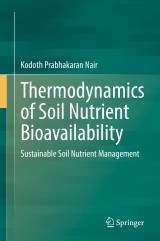Details

Thermodynamics of Soil Nutrient Bioavailability
Sustainable Soil Nutrient Management|
139,09 € |
|
| Verlag: | Springer |
| Format: | |
| Veröffentl.: | 19.08.2021 |
| ISBN/EAN: | 9783030768171 |
| Sprache: | englisch |
Dieses eBook enthält ein Wasserzeichen.
Beschreibungen
This book focusses on the thermodynamics of soil nutrient bioavailability, and in particular the most important plant nutrients such as, phosphorus and potassium, among major nutrients, and zinc among micronutrients. It proposes a paradigm shift in the approach to global soil testing procedures. Historically, soil testing has been used to quantify availability of essential plant nutrients to field-grown crops. However, contemporary soil tests are based on philosophies and procedures developed several decades ago, without significant changes in their general approach. For a soil test to be accurate, one needs to clearly understand the physico-chemico-physiological processes at the soil-root interface and, an understanding of soils and plant root systems as polycationic systems is essential. It is this knowledge that leads to sound prescriptive soil nutrient management inasmuch as soil nutrient bioavailability vis-à-vis fertilizer application is concerned, because, of all the factors which govern sustainability in crop production, the nutrient factor is the most important, yet, it is also least resilient to management. This book provides a clear scientific basis of the thermodynamics of soil nutrient bio availability, which routine soil testing does not provide<p></p>
Chapter 1. Sustainable soil management – what does it imply?.- Chapter 2. Quantifying the bioavailability parameters of a nutrient.- Chapter 3. The nutrient “Quantity”and “Intensity” factors.- Chapter 4. Quantifying the Nutrient Diffusive Flux indirectly.- Chapter 5. Statistical approach to define the Nutrient Diffusive Flux.- Chapter 6. Quantifying plant uptake process.- Chapter 7. Nutrient Uptake Predictability.- Chapter 8. The role of Electro Ultra Filtration technique in measuring P and K “Intensity” factor to construct the “Diffusion Flux Curves”.- Chapter 9. Concluding comments and Future Imperatives.
<p><b>Kodoth Prabhakaran Nair</b> is an eminent international agricultural scientist who has worked in Europe, Africa and Asia for more than three decades, during which time he has held a number of prominent academic positions, including the National Chair of the Science Foundation, The Royal Society, Belgium; Professor and Head of the Departments of Agriculture, Soil Sciences and Basic Sciences at The University Center, The Republic of Cameroon; and Senior Professor at the University of Fort Hare, Republic of South Africa – the alma mater of the late Nelson Mandela, and where he began the struggle against apartheid. Professor Nair is best known, globally, for developing “The Nutrient Buffer Power Concept”, a revolutionary soil management technique that is changing the face of modern farming in the developing world. The recipient of several national and international awards for developing this concept and currently nominated for the 2021 Volvo Environment Prize, he has authored ten books, including “ISSUES IN NATIONAL AND INTERNATIONAL AGRICULTURE”, which was launched by India’s great President, the late Dr. A.P.J. Abdul Kalam in Raj Bhavan, Chennai, India. He has received six invitations to contribute invitational chapters to ADVANCES IN AGRONOMY, the magnum opus of agricultural science, a world record. He is also a Senior Fellow of the world renowned Alexander von Humboldt Research Foundation, The Federal Republic of Germany. Was recently elected Fellow of the National Academy of Agricultural Sciences, India. Currently pursuing global agricultural research, he lives with his wife, Dr Pankajam Nair, a nematologist trained in Europe, in Calicut, Kerala State, India</p>
This book focusses on the thermodynamics of soil nutrient bioavailability, and in particular the most important plant nutrients such as, phosphorus and potassium, among major nutrients, and zinc among micronutrients. It proposes a paradigm shift in the approach to global soil testing procedures. Historically, soil testing has been used to quantify availability of essential plant nutrients to field-grown crops. However, contemporary soil tests are based on philosophies and procedures developed several decades ago, without significant changes in their general approach. For a soil test to be accurate, one needs to clearly understand the physico-chemico-physiological processes at the soil-root interface and, an understanding of soils and plant root systems as polycationic systems is essential. It is this knowledge that leads to sound prescriptive soil nutrient management inasmuch as soil nutrient bioavailability vis-à-vis fertilizer application is concerned, because, of all the factors which govern sustainability in crop production, the nutrient factor is the most important, yet, it is also least resilient to management. This book provides a clear scientific basis of the thermodynamics of soil nutrient bio availability, which routine soil testing does not provide
Offers an original understanding of the thermodynamics of soil nutrient bio availability Proposes a paradigm shift in global soil testing Introduces making fertilizer recommendation farmer centric
Diese Produkte könnten Sie auch interessieren:

Contaminated Soils, Sediments and Water:

von: Edward J. Calabrese, Paul T. Kostecki, James Dragun

149,79 €















